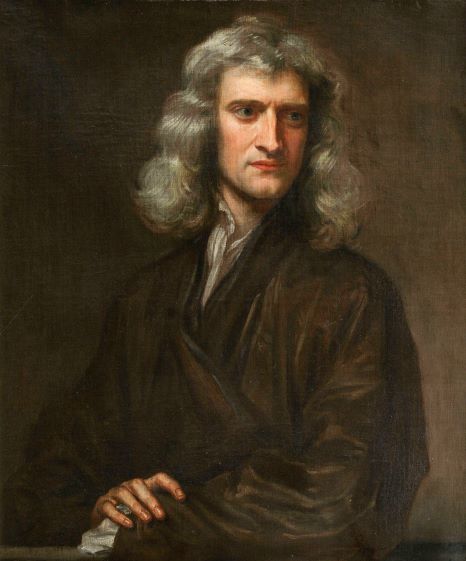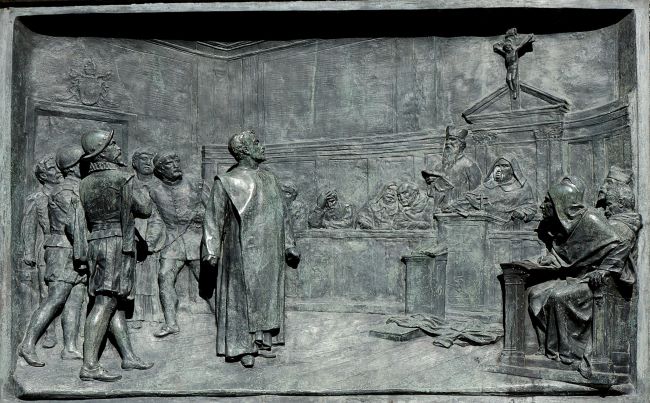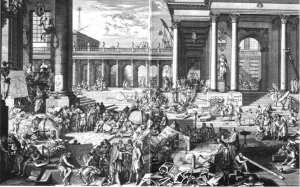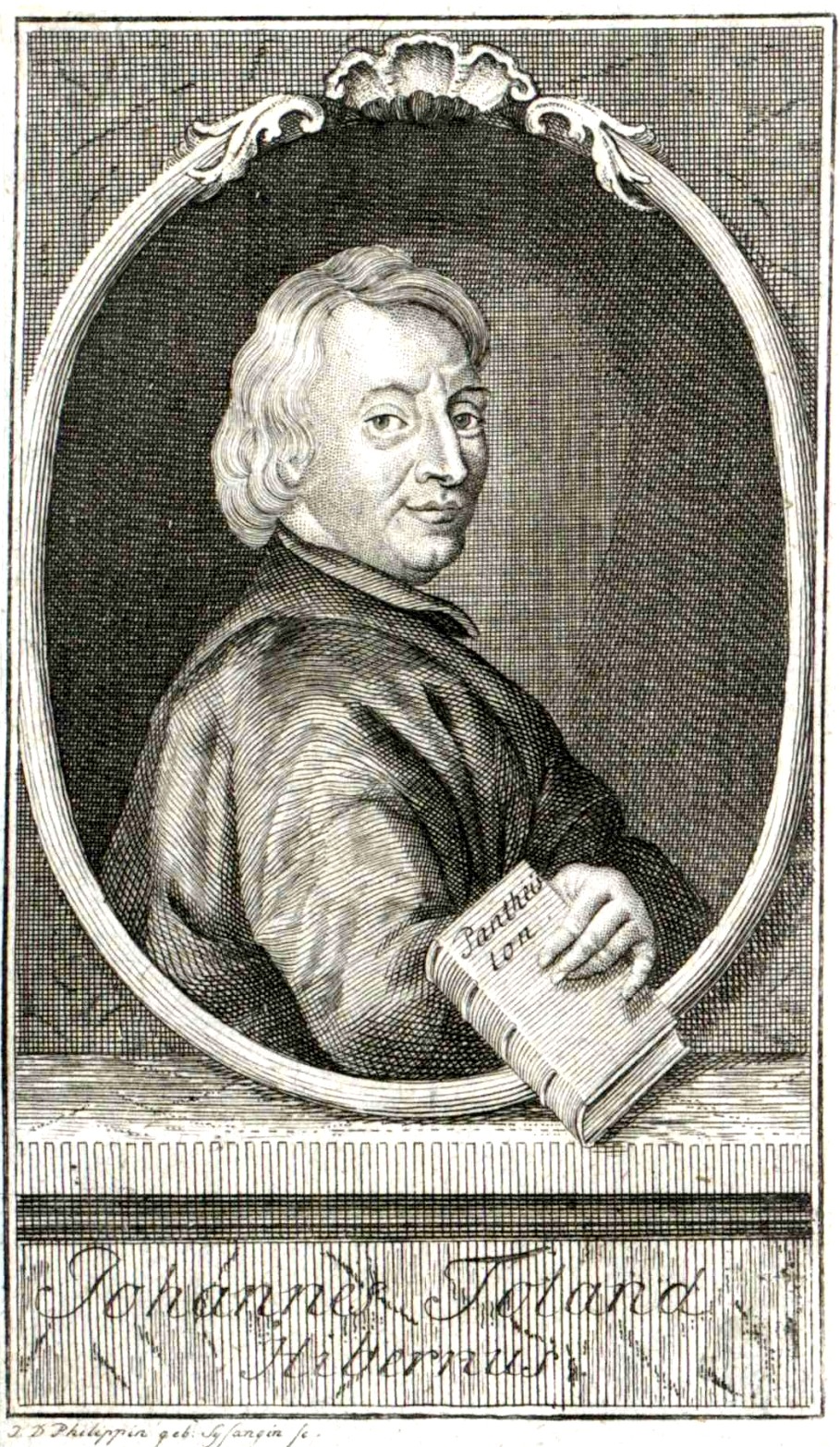Image above: The French Academy of Sciences, 1698
Lest we forget, the birth of modern physics and cosmology was achieved by Galileo, Kepler and Newton breaking free not from the close confining prison of faith (all three were believing Christians, of one sort or another) but from the enormous burden of the millennial authority of Aristotelian science. The scientific revolution of the sixteenth and seventeenth centuries was not a revival of Hellenistic science but its final defeat.- David Bentley
HartIntroductionWe are all familiar with the Enlightenment (late 1600s to early 1800s), not least because we studied it in our history books in school. We also learned that before the Enlightenment - which brought about the gradual re-introduction of science into society - there were the medieval universities of philosophy, known as Scholasticism, that dominated education in Europe from about 1100 to 1700. What we don't hear much about is the transition between the two, how science came to dominate thinking, who was involved, and what was there before. The study of early science texts in the monastic schools contrasted with the superstitious and pantheistic thinking of ordinary people in the form of religious and political dissidents who also advocated early forms of communitarian ideology.
The Scientific Revolution (1543-1687), carried out by people such as Nicolaus Copernicus(1473–1543), Galileo Galilei (1564–1642), Francis Bacon (1561–1626), René Descartes (1596–1650), Isaac Newton(1642–1727), etc., changed the way people thought about nature and created a profound crisis for the church, and the scientists themselves who had to figure out the role of god in this new way thinking, as well as deal with the dissidents who saw in the new science the basis for a democratic and socialist organisation of society itself. The legacy of the Enlightenment today, then, is the two traditions of liberal christianity and science on the one hand, and materialist pantheism, republicanism and socialism on the other. Both sides incorporated science as part of their ideology, but used it for very different ends.
The only known image of Toland
He was an assertor of Liberty
A lover of all sorts of Learning
A speaker of Truth
But no man's follower, or dependant- John Toland's self-composed
epitaph emphasised his lifelong devotion to freedom,
knowledge, and individualism; a distinctly humanist approach to living.
Scholasticism
From earliest times
monasticism employed scientific learning to further the life of the monks and their understanding of the bible. Science was important for time-keeping and seasonal rites. Astronomy was particularly important for Christmas and the calculation of Easter dates each year. With the emergence of medieval universities in the 12th century much emphasis was laid on the rediscovered Aristotle and other scientific Greek thinkers. The monks even used the dialectical method in their discussions, a Greek method for establishing the truth through reasoned argumentation.
Dialectics were later on to become an important part of Marxist analysis of history in place of the determinism of the bible, whereby different opposing forces produce a revolutionary change after a long period of evolution, as opposed to the fixed aspect of god's creation since the beginning of time, as described in the book of Genesis, for example. However, the dialectic was used in Scholasticism to reconcile Christian theology with scientific philosophy, not to further the ends of science itself.
In a way it could be argued that the church was endeavouring to combat the rising new interest in science as it posed a threat to the basics of church thinking and teaching. The rise of Aristotelian ideas and their interpretation by the medieval Andalusian philosopher Averroes generated controversies in Christendom that led to the Catholic Church taking steps to deal with their implications, with Thomas Aquinas (1225–1274) laying down an an acceptable interpretation of Aristotle, and the condemnation of Averroist doctrines in 1270 and 1277.
Thirteen propositions were listed as false and heretical, some related to Averroes' doctrine of the soul and others directed against Aristotle's theory of God as a passive unmoved mover. For example, the
propositions "That human acts are not ruled by the providence of God", "That the world is eternal", and "That there was never a first human" had obvious signs of influence from scientific investigation and threatened basic tenets of Christian theology.
Moreover, Averroes
argued that "scriptural text should be interpreted allegorically if it appeared to contradict conclusions reached by reason and philosophy." The motive of Scholasticism then was to bring reason to the support of faith by using argumentation to silence all doubt and questioning while, at the same time, maintaining that faith was more important than reason.
On a political level Thomas Aquinas' ideas reflected the hierarchical thinking of the church in that he
considered "monarchy is the best form of government, because a monarch does not have to form compromises with other persons. Aquinas, however, held that monarchy in only a very specific sense was the best form of government - only when the king was virtuous is it the best form; otherwise if the monarch is vicious it is the worst kind." Yet, "unless an agreement of all persons involved can be reached, a tyrant must be tolerated, as otherwise the political situation could deteriorate into anarchy, which would be even worse than tyranny."
John Toland (1670–1722), the Irish rationalist philosopher, threw a spanner into the works when he suggested in his
book,
Christianity Not Mysterious (which was ordered to be burnt), that "the divine revelation of the Bible contains no true mysteries; rather, all the dogmas of the faith can be understood and demonstrated by properly trained reason from natural principles", i.e.,
Natural Law - the "system of right or justice held to be common to all humans and derived from nature rather than from the rules of society." In this case, the rules set by the Church.
From a political perspective Toland took a pantheistic approach to religion, the idea that god was 'immanent' or 'in' nature and not ruling over nature. Therefore, if nature had no need of hierarchy, then man had no need either. Toland believed that there was no need for hierarchy in the
church or the state, "bishops and kings, in other words, were as bad as each other, and monarchy had no God-given sanction as a form of government."
 Portrait of Newton at 46 by Godfrey Kneller, 1689The Scientific RevolutionIn questions of science, the authority of a thousand is not worth the humble reasoning of a single individual.
Portrait of Newton at 46 by Godfrey Kneller, 1689The Scientific RevolutionIn questions of science, the authority of a thousand is not worth the humble reasoning of a single individual.- Galileo
GalileiBy the early 18th century the new science and mechanical philosophy initiated by the Scientific Revolution had profoundly changed
society as "developments in mathematics, physics, astronomy, biology (including human anatomy) and chemistry transformed the views of society about nature." An ideological battle developed between Christian philosophers like Leibniz who tried "to locate the origin of force in a vast spiritual universe, and ultimately therefore in God" and the Newtonians who believed in a "divine presence operated as an immaterial "aether" that offered no resistance to bodies, but could move them through the force of gravitation", that is, an immanent or omnipresent god that was simply a part of nature.
Out of this influence of Newton there arose Enlightenment Deism, the idea that the
universe is "a vast machine, created and set in motion by a creator being that continues to operate according to natural law without any divine intervention". Deism would allow the scientists to continue doing science without the fear of excommunication from the Church, worried about the implications of mechanical philosophy on God's role in the universe. Leibniz, critical of this theological sleight of hand,
quipped: "God Almighty wants to wind up his watch from time to time: otherwise it would cease to move. He had not, it seems, sufficient foresight to make it a perpetual motion."
Deism emphasized the concept of natural theology (that is, God's existence is revealed through nature). Therefore, "Enlightenment Deism consisted of two philosophical assertions: (1) reason, along with features of the natural world, is a valid source of religious knowledge, and (2) revelation is not a valid source of religious knowledge." In practice this meant the rejection of (1) all books (including the Bible) that claimed to contain divine revelation (2) the incomprehensible notion of the Trinity and other religious "mysteries", and (3) reports of miracles, prophecies, etc. Thus, as Margaret C. Jacob writes:
The new mechanical philosophy banished spiritual agencies, inherent tendencies, and anima from the universe. In their place were put explanations based upon those natural properties capable of mathematical calculation. Nature had to be observed and experienced, and wherever possible given mathematical expression. The physical universe became a place with spatial dimensions within which bodies moved at measurable speeds. Bodies moved one another by impulse, that is, my pushing one another and to explanations of the natural world based upon impulse we commonly ascribe the term 'mechanical'.
For Leibniz though, this was political, as he perceived the new naturalistic and materialistic explanations of the universe were being used by 'politically dangerous men' to "disestablish churches and weaken the power of kings and courts."

The trial of Giordano Bruno by the Roman Inquisition. Bronze relief by Ettore Ferrari, Campo de' Fiori, Rome.
Pantheism and MaterialismWhen Adam delved and Eve span,
Who was then the gentleman?- Lollard
priest John Ball
Of course, Toland's pantheism, Aquinas's fear of anarchy, and Leibniz's dread of politically dangerous men were all rooted in an awareness of "popular heresy and social protest coming from the lower orders of society." [4] There were rumblings of dissent associated with radical groups steeped in centuries of paganism that had never been fully overcome by Christian theology. Pantheistic ideas could be found in animistic beliefs and tribal
religions globally "as an expression of unity with the divine, specifically in beliefs that have no central polytheist or monotheist personas." The idea of a distinct personal or anthropomorphic god was not recognised. The 17th-century philosopher Baruch Spinoza (1632-1677) popularised pantheism in the West through his book
Ethics along with the earlier Giordano Bruno (1548–1600), an Italian friar who evangelized about a transcendent and infinite God, but was eventually burned at the stake in 1600 by the Roman Inquisition. As Jacob noted:
The pantheistic materialism of seventeenth-century radicals owed its origin to the magical and naturalistic view of the universe which Christian churchmen and theologians had laboured for centuries to defeat. At the heart of this natural philosophy lay the notion that nature is a sufficient explanation or cause for the existence and workings of man and his physical environment. In other words, the separation of God from Creation, creature from creator, of matter from spirit, so basic to Christian orthodoxy and such a powerful justification for social hierarchy and even for absolute monarchy, crumbles in the face of animistic and naturalistic explanations. God does not create ex nihilo; nature simply is and all people (and their environment) are part of this greater All.
Indeed, the earlier pagan religious practices had co-existed with Christianity, many of which the church had co-opted but the worship of saints (and Mary) almost seemed almost like the continuation of polytheism. As Christopher Scott Thompson writes:
Paganism in this broader sense did not end with the Christian conversion, because it was never limited to "organized religion" in the first place. Regular people all over Europe continued to leave offerings for the fairies and the dead many centuries after the official conversion to Christianity. They didn't think of themselves as "pagans" in any formal sense, but they still thought of the world around them as being filled with spirits and their daily spiritual practices reflected this worldview. They still believed in local fairy queens and fairy kings, entities that would have been understood as gods before the Christian conversion. They also retained a semi-polytheistic worldview in the veneration of saints, many of which were not recognized as saints officially by the church and a few of which were originally pre-Christian gods.
Furthermore, the radical peasants used elements of paganism and and communitarian ideas in the bible to underpin their struggle against oppression by kings, queens, landowners and the aristocracy:
Peasants resisting feudalism sometimes turned to this tradition of magic and spirit worship for aid against their oppressors. For instance, Emma Wilby's The Visions of Isobel Gowdie documents how folk beliefs about fairy kings and the malevolent dead were used by magic practitioners in 17th century Scotland to curse feudal landowners. [...] These practices existed alongside organized religion yet distinct from it, before the Christian conversion and after it. People cultivated relationships with the spirits of nature, the dead and other entities for help with their practical daily problems — including how to effectively resist oppression.
In England, for example, the radicals organised in groups such as the Diggers, Ranters, Levellers, Muggletonians, Familists and Quakers, some of whom believed that the "Scripture foretold of a democratic order where property would be redistributed", for example, in Acts 2:
42 They devoted themselves to the apostles' teaching and to fellowship, to the breaking of bread and to prayer. 43 Everyone was filled with awe at the many wonders and signs performed by the apostles. 44 All the believers were together and had everything in common. 45 They sold property and possessions to give to anyone who had need.

Woodcut from a Levellers document by William Everard
Materialism reflected the pagan, pantheistic worldview, as it "holds matter to be the fundamental substance in nature, and all things, including mental states and consciousness, are results of material interactions" (The idea that man created god, in stark contrast to the idealist view that god created man). This materialism was eventually combined with the aforementioned dialectics to form the basis of Marxian philosophy and change radical group ideology from pantheistic communitarianism to atheistic socialism. Thus, the non-hierarchical aspect of pantheism found its natural home in radical communitarian thought which was rejected by conservative forces, as Jacob states:
At every turn they rejected mechanistic explanations that hinged upon the power of matter unassisted by spiritual forces separate from the natural order. To their mind, scientific materialism, whether mechanistic or pantheistic in its inclination, justified atheism, social levelling, political disorder, in short the turning of 'the world upside down'.The desire to turn 'the world upside down' was exhibited most famously by the religious and political dissidents known as the Diggers. They put their ideas into practice when they took over some
common land in Surrey:
The Council of State received a letter in April 1649 reporting that several individuals had begun to plant vegetables in common land on St George's Hill, Weybridge near Cobham, Surrey at a time when harvests were bad and food prices high. Sanders reported that they had invited "all to come in and help them, and promise them meat, drink, and clothes." They intended to pull down all enclosures and cause the local populace to come and work with them. They claimed that their number would be several thousand within ten days. "It is feared they have some design in hand."Their leader, Gerrard Winstanley (1609–1676) was an English Protestant religious reformer, political philosopher, and activist. The radical nature of the Diggers' ideology is demonstrated in the difference between the Diggers and the Levellers, as, while the Levellers sought to "level the laws" (while maintaining the right to the ownership of real property), Winstanley
sought to level the ownership of real property itself, which is why he and his followers called themselves "True Levellers".
Winstanley underpinned this radical ideology in combined passages from the bible and pantheist thinking in his
writings:
In the beginning of Time, the great Creator Reason, made the Earth to be a Common Treasury, to preserve Beasts, Birds, Fishes, and Man, the lord that was to govern this Creation; for Man had Domination given to him, over the Beasts, Birds, and Fishes; but not one word was spoken in the beginning, That one branch of mankind should rule over another. And the Reason is this, Every single man, Male and Female, is a perfect Creature of himself; and the same Spirit that made the Globe, dwels in man to govern the Globe; so that the flesh of man being subject to Reason, his Maker, hath him to be his Teacher and Ruler within himself, therefore needs not run abroad after any Teacher and Ruler without him, for he needs not that any man should teach him, for the same Anoynting that ruled in the Son of man, teacheth him all things... And so selfish imaginations taking possession of the Five Sences, and ruling as King in the room of Reason therein, and working with Covetousnesse, did set up one man to teach and rule over another; and thereby the Spirit was killed, and man was brought into bondage, and became a greater Slave to such of his own kind, then the Beasts of the field were to him.
The Diggers were harassed on St George's Hill by organised gangs. They endured beatings and an arson attack on one of their communal houses. They were taken to court (but not allowed to speak in their own defence) and when they lost their case they had to leave the land or risk the army moving in and evicting them. Other Digger colonies were set up around different parts of England as their influence spread. Winstanley had to flee but
continued to advocate the redistribution of land.
Conclusion
While ultimately the Digger movement failed, the Enlightenment developed out of the Scientific Revolution as the 17th century bequeathed two contradictory traditions to the future. On the one hand there was the predominant "moderate and liberal Christianity wedded to the new science and supportive of strong monarchy within a constitutional framework" while, on the other hand, a republican tradition "in conformity with a pantheistic and materialistic understanding of nature." Two opposing traditions that are very much to the fore in politics today.








